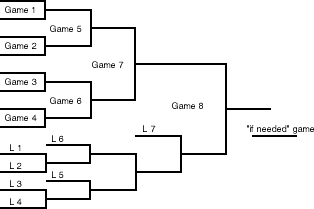I've actually been working on a web-based solution to these problems. It's early days but mostly works. If I can find a few more hours coding time between family and work I'll be able to get something online for people to criticiseFrom the discussions following AWS40 it seems we can improve on how we run the AWS. This is no criticism of Will and his team, but an acknowledgement that there is always room for improvement.
So what have we learned?
1. It's not very broke, so don't over-fix it! It was only a bit over time so let's not go too mad.
2. The pits need to be close to the arena.
3. We need to improve the visibility of upcoming fights so that people are ready and fight changes are faster.
The biggest challenge and the biggest effect is improving the visibility of what's happening. Who's in, who's out, which round/group we are in etc etc.
AntLog was designed as a logging tool, not really an event management system. It handles its designed task well, but one consequence of its design is that upcoming fights are not always visible. Simply projecting it on a big screen won't improve things very much.
So what do we need from an event management system? I would suggest the following requirements (I'm sure I've missed a few):
1. Must be stand-alone and not rely on an internet connection
2. Must handle up to 128 entrants
3. Must handle multiple groups or some other method of keeping robots from the same team apart as long as possible
4. Must provide visibility of upcoming fights, even when these are in different groups
5. Should be free so that any number of people can download/install/use it
6. Should not rely on other paid applications (e.g. Microsoft Office)
7. Should work on multiple platforms, Windows, Linux, MacOS
I have looked around and failed to find anything that comes even close to meeting these criteria. If anyone knows of or can find anything suitable it would be great!
The other option is to come up with something of our own. I am happy to contribute but would really appreciate some help if anyone is willing/able. Discuss...
_________________
Gary, Team BeligerAnt
The system actually completely dispenses with 'groups' since there's no need if you've got a computer and a database behind it, groups are only necessary if you want to compartmentalise a league-style system. Opponents for each bout are chosen on a weighting system which biases the decision based upon the double-elimination chart theory in a round-by-round approach.
The advantage of a web based system with a backend DB is that you can have many web interfaces open at the same time, one for the administration, one for the 'recent bouts', one for the 'upcoming bouts', etc. It also means that people with much more talent than I can design the look with CSS
Note: If you're worried: The double-elimination logic doesn't change nor the flow from first round to final stages, they're just no longer called quarter-final, group-stages, semi-final and final. These are labels we can add at a later date. Because of the way the database works the logic to choose single, double or even triple elimination is trivial and can even be changed mid-competition.
